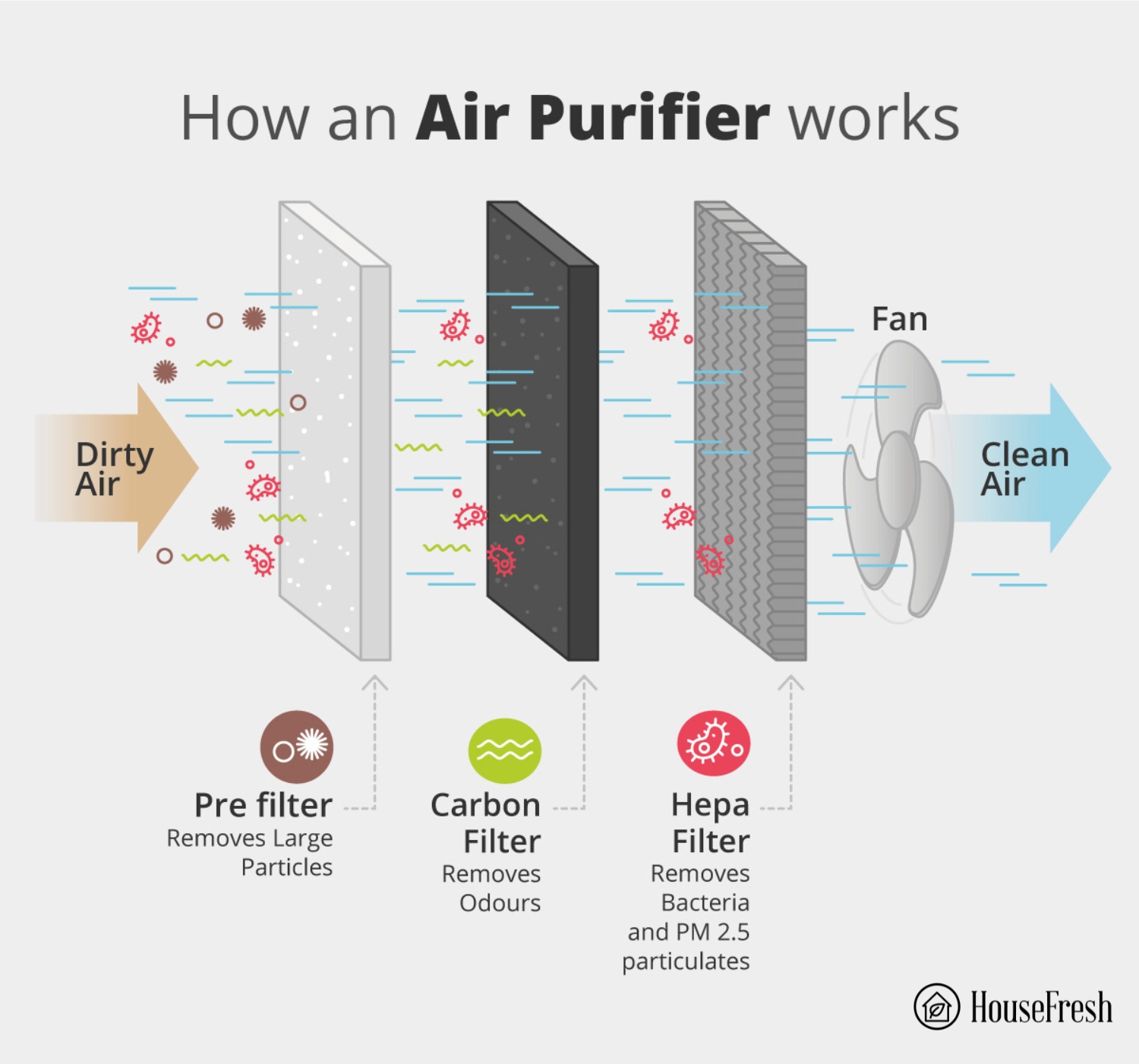Modern-day life is full of challenges, from little things like what groceries to buy to major issues like pollution slowly poisoning us in our own homes. No big deal, right?
Well, seeing as over 34 million Americans suffer from respiratory problems like asthma, it’s a pretty big deal. Airborne triggers such as allergens, bacteria, and viruses pose a very serious threat to our health and well-being in this day and age.
Investing in an air purifier or dehumidifier (or both) might be a necessity for those who are conscious about their health and well-being. But knowing which appliance is best for your needs isn’t always straightforward.
The key differences between an air purifier and a dehumidifier
They might look the same, but don’t be fooled. They have completely different uses. Here’s a breakdown of their main differences:
1. An air purifier removes particles from the air

You can’t see it, but the air around you is full of pollutants and particulates that you inhale, which can ultimately affect your health.
What type of pollutants are floating around your home, you may ask. They can range from everyday pollutants such as household dust or traffic pollution to volatile organic compounds (VOCs) like formaldehyde emitted from your furniture and carpets.

To keep these pollutants at bay, you can use an air purifier that draws in air and captures unwanted particles as they pass through a series of filters. That then leaves clean, healthy air that gets recirculated around your home.
Air purifiers come with various types of filters. However, the vast majority use mechanical filters like HEPA and activated carbon, which are highly effective at reducing allergens and smoke and are even recommended for use against viruses such as COVID-19.

A High Efficiency Particulate Air filter (HEPA) is made up of tightly woven fiberglass strands designed to remove particulates from the air. The HEPA stamp of approval guarantees that the purifier can capture 99.97% of particles as small as 0.3 microns.
Activated carbon filters work against gas particles known as VOCs. The filter contains quantities of carbon or charcoal substrate, which locks pollutants such as odor or chemical fumes to the carbon pores through a process known as adsorption.
2. A dehumidifier removes excess moisture from the air

While a purifier removes pollutants, a dehumidifier removes water molecules from the air.
The process starts in a somewhat similar way, as the humidifier also draws in air. But that’s where the similarities end. The next stage of the process depends on what type of dehumidifier you own: either a refrigerative or desiccant dehumidifier.

- Refrigerative dehumidifiers cool humid air to create condensation (think of hot breath on a cold window pane). The condensation then collects in the unit’s internal reservoir as the dry air is warmed back up to room temperature and redistributed around your space.
- Desiccant dehumidifiers pass humid air through a revolving desiccant wheel, which acts like a sponge to draw moisture from the air. Heaters then warm the dry air, ready to be expelled into the space, as well as heating the desiccant material to maintain its moisture-absorbing properties.

Dehumidifiers don’t have filters, so they can’t remove airborne pollutants like an air purifier can. What they can do is create an environment that certain pollutants struggle to survive in. Many larger compressor dehumidifiers will include a filter, but this is designed to protect the internal coils from dust particles, not to clean your room’s air.

By regulating humidity in your home you can reduce exposure to many common allergies, prevent mold and mildew growth, and create an inhospitable environment for pests like cockroaches and dust mites.
The CDC recommends maintaining a humidity level between 30 and 50% to stop the spread of mold, dust mites, and pests.
When to choose an air purifier over a dehumidifier
Both air purifiers and dehumidifiers can be a pretty sizable investment. Therefore, it’s important to know exactly when to buy an air purifier or a dehumidifier. You don’t want to spend all that money just for nothing to happen.
What an air purifier can help with
What an air purifier won’t do
If you’re looking for protection from a wide range of indoor air pollutants, then an air purifier is what you need. These units can target the smallest airborne particulates as well as VOCs, creating a healthier environment within your home.
When to choose a dehumidifier over an air purifier
You might live in a humid region and desperately need dehumidifying to combat damp and mold. Then, an air purifier probably isn’t the priority.
What a dehumidifier can help with
What a dehumidifier won’t do
For homes with damp or excessive moisture, a dehumidifier is the ideal choice. By controlling humidity in your home, you can expect to resolve issues with mold and mildew while creating an environment less susceptible to dust mites, invaders, and even bacteria.
To conclude
Air purifiers and dehumidifiers may look similar, but they serve completely different purposes.
They’ll both improve the overall indoor quality of your home, but each space has different challenges that you’ll need to consider before investing in these appliances.
A dehumidifier is the logical solution for homes that struggle with excess humidity. It controls moisture levels, creating a healthier environment where mold, mildew, and dust will be less problematic.
On the other hand, air purifiers are ideal if you’re affected by a wide range of pollutants. By removing the problematic particles from your air, you can breathe easier in the knowledge your home is free from microscopic allergens and toxins that can contribute to an array of health issues.
In a perfect world, you’d have both. When you have both appliances, you can get rid of pollutants and excess moisture. Double whammy. You can check out our recommended air purifiers and dehumidifiers if you want thorough analysis and real in-hand reviews.
SOURCES
- American Lung Association. (2024). Our Impact. lung.org
- Asthma + Lung UK (2024). Improving indoor air quality. asthmaandlung.org.uk
- Asthma and Allergy Foundation of America. (2015). How Can I Control Indoor Allergens and Improve Indoor Air Quality? aafa.org
- Centers for Disease Control and Prevention. (2024). You can control mold. cdc.gov
- Centers for Disease Control and Prevention. (2022). Improving the Air in Your Home. cdc.gov
- Hockman, C. (2020). Optimal Conditions for Viral Transmission. americanscientist.org
- Mondal, S and Saha, P. (2019) Removal of VOCs and Improvement of Indoor Air Quality Using Activated Carbon Air Filter. researchgate.net
- United States Environmental Protection Agency. (2024). Air Cleaners and Air Filters in the Home. epa.gov
- Wolkoff, P. (2018). Indoor air humidity, air quality, and health – An overview. sciencedirect.com





